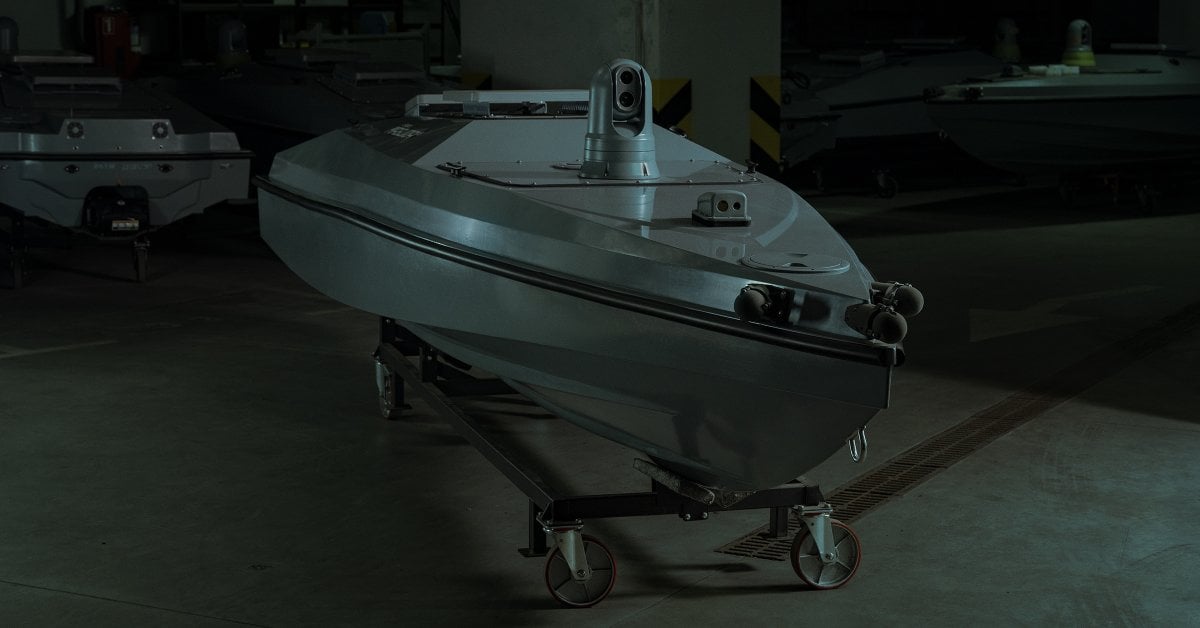
“Here she comes,” said the drone operator. “Get ready to grab it.” From the shore we could see the vessel coming, its nose bobbing in the waves as it approached the naval base. A few soldiers stood beside me on the beach, squinting and sweating in the midday sun. One of them, a technician from Ukraine’s military intelligence service, waded into the water with a pair of rubber boots and let the machine float into his arms. Then he stroked it gently, like a doting father, and looked back to gauge my reaction.
[time-brightcove not-tgx=”true”]Up close, the weapon looked small and strange, about as threatening as a research vessel meant to measure the movement of tides. No gun barrels stuck out of it. No shark-teeth decals to match its deadly reputation. No sign of the explosives such boats are designed to carry. Yet here it was, the Magura, scourge of the Russian navy, the seaborne drone that has helped change the course of the war in Ukraine, pierce Russia’s blockade of the Black Sea, and revolutionize maritime warfare.
Though it has no large warships in its navy, Ukraine has used these drones to outmaneuver one of the greatest naval powers in the world. Produced at a cost of around $200,000 apiece, the weapons have damaged or destroyed about two dozen Russian warships—as much as a third of the Black Sea fleet, including large landing ships and missile carriers worth billions of dollars. These strikes have forced the rest of the Russian navy to pull back from Ukrainian shores, all but conceding defeat in the greatest sea battle Europe has seen since World War II.
Standing on that beach, nose to nose with the Magura, it was hard to believe this motorized dinghy could score such an epic victory. Russia’s status as a naval power dates back more than three centuries to the age of Peter the Great, the Russian czar who was so obsessed with battleships that he once traveled in disguise to the Netherlands to learn how to make them. Now, thanks to a drone conceived in a Kyiv garage, the Russian navy has begun to look useless along a critical front in the war. Vladimir Putin knows it. In February, he fired the commander of the Black Sea fleet; a month later, he sacked the head of the entire Russian navy as the Ukrainian drone strikes intensified.
“So, what do you think,” one of the engineers asked me on the beach. “You want to drive it?”

For Ukraine’s spy agencies, the invitation seemed out of character. They tend to guard their secrets well, and their drone bases have been a favorite target for the Russians. But I could understand their desire to show off this base and its arsenal. The need for Ukraine to make advances—and to flaunt them—has intensified in recent months, as President Volodymyr Zelensky pursues a strategy to end the war by inflicting as much pain on the Russians as possible.
Perhaps the boldest move in this strategy began in early August, when the armed forces of Ukraine smashed through the Russian border and seized about a thousand square kilometers in the course of a week. The assault put an end to the gory stalemate that had long defined the war, and it gave Zelensky a valuable card to play against the Russians. “To all appearances,” Putin said a few days after the attack, “the enemy is trying to improve its negotiating position.”
He was right, and not only about the incursion into Russia. On the opposite side of the war zone, Ukraine has spent months improving its negotiating position in the Black Sea, where its attacks could give Zelensky an edge in any future peace talks. Apart from crippling the Russian navy, they have allowed Ukraine to make a credible threat against Russian ports and naval bases, as well as the tankers Russia uses to export its oil. “The only thing the Russians understand is the language of force,” says Zelensky’s chief of staff, Andriy Yermak, who oversees the nascent peace process. “They will not stop the war unless they feel the danger of continuing to fight us.”
At the start of the Russian invasion, few imagined that Ukraine could hold its own against the Russians and, on many fronts, humiliate them. The balance of forces at sea seemed especially hopeless for the Ukrainians. The fleet of warships they inherited in 1991, after the collapse of the Soviet Union, had been eroded by decades of mismanagement, and most of its ships were seized by the Russians in 2014, along with the entire Black Sea region of Crimea.
Eight years later, what remained of Ukraine’s creaking navy stood no chance against the nuclear-armed flotillas that Russia brought to the fight. On that first day, February 24, 2022, the flagship of the Russian fleet, a gigantic missile cruiser called the Moskva, appeared near the shore of Snake Island in the Black Sea, a tiny fleck of land where the Ukrainian border guard service maintained a barracks and a radar station. Over the radio, the Russians demanded the surrender of the troops on the island. The Ukrainian response came back with little hesitation: “Russian warship, go f*** yourself.”

Soon the Moskva opened fire, and all of the island’s defenders were killed or captured. But their initial answer became a Ukrainian battle cry, stenciled on T-shirts, graffitied on walls and even printed on a postage stamp. About two months later, Ukraine launched a counterstrike against the Moskva using a pair of anti-ship missiles. Several hundred Russian sailors were forced to abandon the ship or go down with it. From his bunker in Kyiv, President Zelensky watched images of the Russian flagship in flames. He sensed that it would mark a turning point. “This changes the position of the pieces on the chess board,” Zelensky told me few days later.
Still, the game continued to favor the Kremlin. From their balconies near the shore, Ukrainians could see the armada of enemy warships on the horizon. They had imposed a blockade of Ukraine’s largest port in Odesa, cutting off cargo traffic and leaving ships stranded in the harbor. To prevent the invaders from landing on the beaches, the Ukrainians laid mines in the sand and along the southern coast. Zelensky’s team realized that, without the ability to export goods by sea, the national economy would suffocate. More than half of all goods produced in Ukraine were exported by sea before the war.
Because of the Russian blockade, over 20 million tons of Ukrainian grain remained stuck in its ports, and food prices soared in many regions of the world. Poorer nations in Africa and the Middle East faced the risk of famine. To alleviate the crisis, the U.N. and Turkey proposed a deal in the summer of 2022 to resume the export of Ukrainian grain. Russia accepted the terms that July, allowing roughly a thousand cargo ships to carry Ukrainian food to the global market. But, as the fighting at sea intensified, the deal began to unravel.
Like a lot of high-tech origin stories, the birth of Ukraine’s naval drones took place in a garage. This one stands behind a country house near the edge of Kyiv, with a roll-up door, a concrete floor, and an adjacent garden full of spindly trees and rose bushes. In the spring of 2022, as the fighting raged in the suburbs of Kyiv, a group of friends would gather at the house to keep each other company and monitor the news. They came from different fields—former officials, engineers, corporate executives, tech investors. Their families had mostly fled the city, while they stayed behind to look for ways to help.
“We all realized we would not be much use running around with assault rifles,” one member of the group told me during a recent visit to the house. Instead, they started researching weapons and tinkering in the garage. Among their early innovations was to attach a Starlink satellite dish to the top of a quadcopter, dramatically increasing its range of operation. The resulting drone could crisscross the front lines anywhere in Ukraine, monitoring Russian positions or dropping grenades on top of them. The weapon soon became so ubiquitous and deadly in the war zone that the Russians gave it a nickname: Baba Yaga, which translates roughly as the Wicked Witch.
Ukraine’s armed forces recognized its potential. During a meeting with the designers that spring, Brigadier General Ivan Lukashevych, a senior intelligence officer, proposed a public-private partnership. He wanted the engineers to make a seaborne version of their drone by attaching a Starlink to a motorboat. “It wasn’t rocket science,” said one of the designers. They got it done in a few weeks, writing the code themselves and chipping in to pay for parts, which cost around $100,000.
By the end of summer, they had built and tested a small fleet of these boats, and the high command gave them permission to launch an attack, the first one to use naval drones in the Black Sea. The target was the port of Sevastopol, home of the Russian Black Sea fleet, on the southwestern edge of Crimea. From a command center hidden five stories beneath a Kyiv office building, Lukashevych oversaw the mission alongside his boss, SBU director Vasyl Maliuk, and the head of the Ukrainian navy, Vice Admiral Oleksiy Neizhpapa. “The weather conditions were ideal,” Lukashevych later told me of that day. “And the Russians had no idea what was coming.”
But as the operators maneuvered the drones toward Sevastopol, the images on their screens began to crackle and, one by one, they went dark. The Starlink devices used to control the drones had stopped working. SpaceX, the American company that produces the Starlink, did not want its technology to be used for such an operation in Crimea. “Starlink was not meant to be involved in wars,” Elon Musk, the founder of SpaceX, later explained in an interview with his biographer. “It was so people can watch Netflix and chill and get online for school and do good peaceful things, not drone strikes.”
The Ukrainians were baffled. “It cost us the entire operation,” Lukashevych says. The general ordered Ukraine’s engineers to find a workaround, and in the months that followed, they redesigned the communication systems on their drones and used them to launch a series of attacks.
Perhaps the most painful one for the Russians took place on July 17, 2023, when a squadron of drones struck the bridge that links Russia to Crimea. The explosions caused serious damage, not only to Russia’s supply lines but its image as a military juggernaut. Although the Kremlin did not reach for its nuclear arsenal, it did respond with a series of missile strikes against the ports of Odesa and other Ukrainian cities. Worse yet, in the days that followed, the Russian blockade of the Black Sea resumed.
The impact on Ukraine’s economy was devastating. The bombardment of Odesa destroyed more than half a million tons of grain and much of its port infrastructure. Exports ground to a halt. For a while, Ukraine tried to circumvent the blockade by shifting cargo to a smaller port on the Danube river. But Russia responded by bombing that port relentlessly, attempting to close off every avenue for Ukrainian goods to reach global markets. The Ukrainians saw only one way to break through it. They would need to respond with force.
“President Zelensky set the task,” says Maliuk, the SBU director. During a meeting in Zelensky’s office at the end of July, Maliuk and other senior officials discussed how their drone program had evolved over the previous year, with faster and more agile vessels designed to hunt Russian ships at sea. The SBU had produced a series of drones it called the Sea Baby, which could carry far more explosives. By the end of the meeting, Maliuk recalls, the orders from Zelensky were clear to all the members of the war council: “Put an end to the dominance of the Russian Federation in the waters of the Black Sea.”
In order to achieve that, they decided to target the strategic Russian port of Novorossiysk. Apart from housing some of Russia’s biggest warships, the port serves as a hub for the export of oil, the lifeblood of Russia’s war economy. Striking it would signal to the Kremlin that its blockade of Odesa would come at a price. “We needed the Russians to understand we have nothing to lose. If our ports on the Black Sea don’t work, theirs won’t either,” recalls one of the government ministers at the meeting, Oleksandr Kubrakov, who oversaw all Ukrainian ports and shipping routes at the time. “The president said: Alright, let’s try it.”
A few days later, Kubrakov was on an overnight train to Kyiv when his phone lit up with a series of videos from the SBU. One showed a naval drone approaching its target in the port of Novorossiysk, a massive Russian landing ship called the Olenegorsky Gornyak, and blasting a hole in its side. The ship was so badly damaged that it had be towed back to port. For the rest of the Kremlin’s fleet, the attack proved that Ukraine could sink ships far from the war zone. “The Russians are no longer rulers of the Black Sea,” Maliuk, the SBU director, says in describing the results of the operation. “They are forced to hide their ships.”

Many of them retreated to more distant ports and avoided approaching the coastline of Ukraine. Within two weeks, the ports of Odesa began to come alive. Cargo ships that had been stuck for months now ventured into the Black Sea, blowing their horns in celebration as they left the harbor. The Russians tried to stop them. In the middle of August 2023, Russian marines fired warning shots across the bow of a cargo ship heading to Ukraine. They then landed a helicopter on top of it and questioned the crew at gunpoint.
The show of force had little impact. Ukraine’s attack on the Olenegorsky Gornyak had shown the Russian navy that, if it fires on civilian ships in these waters, the Ukrainians could do the same around Novorossiysk. To Zelensky and his team, it felt like a breakthrough. They had outmaneuvered the invaders with little more than a team of drone operators, a small fleet of boats, and a willingness to call Putin’s bluff.
The world’s largest naval powers took note. For all its gargantuan size, the Russian navy “proved no match for Ukraine’s maritime innovations,” the British defense ministry concluded in a battlefield assessment. With the Olenegorsky Gornyak out of commission, “the remaining Russian fleet has been pushed east, fleeing persistent Ukrainian attacks.”
A few months after that strike on Novorossiysk, President Zelensky traveled to Black Sea coast, and he invited me to come along. The presidential train took most of the night to cross the country from north to south, and it came to a stop the next morning in the middle of a field where fuel cisterns and grain wagons stood idle on the tracks. A convoy of armored cars got us the rest of the way to Odesa.
The aim of the trip, Zelensky said, was to promote the new corridor that Ukraine had carved through the Black Sea. About two dozen civilian ships from around the world had already used it in defiance of the Russian blockade, hauling some 800,000 metric tons of cargo. The first trips were risky. No banks would insure the cargo against the threat of a Russian missile or mine. For protection, the ships could only hug the coast in the hope of avoiding the Russian navy in international waters. But once the new route saw its first successful shipments, Zelensky knew that more would come.
At the port of Odesa, he had arranged to meet with Mark Rutte, the prime minister of the Netherlands, which is home to Europe’s biggest sea port. Dutch ships had so far avoided crossing the Russian blockade. But Rutte was eager to see the route Ukraine proposed. Arriving in a separate convoy, he followed Zelensky on a tour of the damage the port sustained in a recent missile strike. The remains of a hotel stood at the end of a pier, its facade reduced to a husk of burned-out rooms and shattered windows.
The backdrop did little to help Zelensky make his pitch. He needed the Dutch to send their cargo ships to Ukraine and to sell insurance to others. Without it, Ukraine’s economy had little chance of recovery. On a poster at the peer, officials had printed photos and statistics of Russian strikes against the ports. “152 targets,” Rutte said in disbelief as he looked at the poster. “But not vessels?” he asked. “Only ports?”
Zelensky nodded. Russian missiles had damaged a few civilian ships in Ukraine, but only those docked in the harbor, not in the sea. The Dutch prime minister did not seem entirely reassured, and he decided to change the subject. “You guys were able to take out some of their ships,” Rutte said, referring to the Russians. “You were quite successful.”
Zelensky smiled and lowered his voice. “Yes,” he said. “In Novorossiysk.”

He was glad to have something to brag about. Throughout that summer, the armed forces of Ukraine had been taking horrific losses as they tried to storm Russian trenches and claw back territory. The front line in eastern Ukraine appeared to be stuck, with neither side able to dislodge the other. But here in Odesa, Zelensky could demonstrate a victory over the Russians. “They don’t control the sea any more,” the president said. “Not all of it.”
The Dutch soon decided to step up their support for the Black Sea shipping corridor, committing new patrol boats and air-defense systems to help Ukraine protect it. The assistance helped bring down the cost of insurance for cargo, enticing more ships into Ukrainian ports. Within a few months, the export of grain reached pre-war levels, averaging around four million tons per month, a lifeline that helped Ukraine’s economy return to growth. “You continue to feed the world,” Rutte said during his visit to Odesa, “as you have always done.”
On a sunny morning in June, about nine months after my visit to Odesa with Zelensky, the team behind the Magura drone offered me a tour of their workshop. Russian missile strikes had forced them to relocate several times, and their new facility, accessible through several layers of security, was deep enough underground to withstand a direct hit. Still, the engineers declined to tell me their names or let me photograph their faces. Anyone linked to the drone program, they said, would become a target.
At one of their workstations, a metallic cylinder about the size of a beach ball dangled from a crane. “That’s the warhead,” my guide told me. Once loaded with plastic explosives, it would be placed inside the nose of a naval drone and rigged with detonators. “One of these is enough to punch a hole right through an aircraft carrier,” the guide said. Would that be enough to sink it? “Probably not. But if you hit it with five or six of these, then yes, it’s going down.”
On a typical mission at sea, at least a handful of these weapons travel in a swarm, some equipped with electronic warfare systems to jam the signals of enemy drones, others to fire rockets or drop mines in the water. The workshop can churn out dozens of them every month. The Magura, named after a warrior goddess in Slavic mythology, specializes in hunting warships far from shore, and they have reportedly claimed 18 successful strikes against the Russians since the summer of 2023.
Would such drones be enough to end the war? Certainly not on their own. But as Zelensky and his generals are careful to emphasize, the greatest impact of these weapons may be psychological. They demonstrate the weaknesses in Russia’s arsenal and the hollowness of Western fears of escalation in this war. When Ukraine struck out against the Russian navy, Putin pulled back his ships to keep them alive. He did not reach for his nuclear arsenal even when Ukraine launched an incursion across the border. For now, the Ukrainians remain in firm control of the Russian town of Sudzha, along with dozens of nearby villages, and the Kremlin has struggled to mount a response.
“We are now witnessing a significant ideological shift,” Zelensky said in a speech on August 19, nearly two weeks into the incursion. “The whole naive, illusory concept of so-called red lines regarding Russia, which dominated the assessment of the war by some partners, has crumbled these days somewhere near Sudzha.”
Unlike the Russians, Ukraine has expressed no plans to seize its neighbor’s land for good. But the occupation of Sudzha, like the bombing of the Olenegorsky Gornyak, has given Zelensky a chance to dictate the terms of a peace to the Russians. If they want their territory back, and if they want to keep their ships afloat, then they will need to offer something in return. That appears to be Zelensky’s vision for negotiations: not suing for peace, but demanding it.
“It is important that our partners are in sync with us in their determination,” he said in his speech. “We must force Russia, with all our might and together with our partners, to make peace.”



























